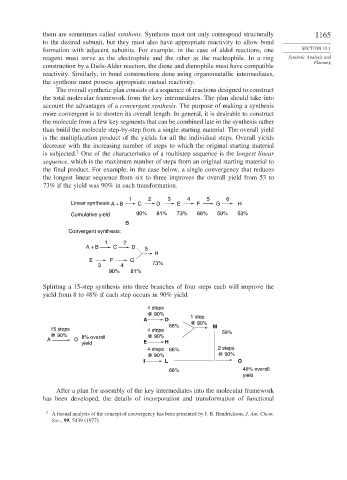Page 1189 - Advanced Organic Chemistry Part B - Reactions & Synthesis
P. 1189
them are sometimes called synthons. Synthons must not only correspond structurally 1165
to the desired subunit, but they must also have appropriate reactivity to allow bond
formation with adjacent subunits. For example, in the case of aldol reactions, one SECTION 13.1
reagent must serve as the electrophile and the other as the nucleophile. In a ring Synthetic Analysis and
Planning
construction by a Diels-Alder reaction, the diene and dienophile must have compatible
reactivity. Similarly, in bond constructions done using organometallic intermediates,
the synthons must possess appropriate mutual reactivity.
The overall synthetic plan consists of a sequence of reactions designed to construct
the total molecular framework from the key intermediates. The plan should take into
account the advantages of a convergent synthesis. The purpose of making a synthesis
more convergent is to shorten its overall length. In general, it is desirable to construct
the molecule from a few key segments that can be combined late in the synthesis rather
than build the molecule step-by-step from a single starting material. The overall yield
is the multiplication product of the yields for all the individual steps. Overall yields
decrease with the increasing number of steps to which the original starting material
2
is subjected. One of the characteristics of a multistep sequence is the longest linear
sequence, which is the maximum number of steps from an original starting material to
the final product. For example, in the case below, a single convergency that reduces
the longest linear sequence from six to three improves the overall yield from 53 to
73% if the yield was 90% in each transformation.
1 2 3 4 5 6
Linear synthesis: A + B C D E F G H
Cumulative yield 90% 81% 73% 66% 59% 53%
B
Convergent synthesis:
1 2
A + B C D 5
H
E F G
3 4 73%
90% 81%
Splitting a 15-step synthesis into three branches of four steps each will improve the
yield from 8 to 48% if each step occurs in 90% yield.
4 steps
@ 90%
A D 1 step
66% @ 90% M
15 steps 4 steps
@ 90% 8% overall @ 90% 59%
A O
yield E H
4 steps 66% 2 steps
@ 90% @ 90%
I L O
66% 48% overall
yield
After a plan for assembly of the key intermediates into the molecular framework
has been developed, the details of incorporation and transformation of functional
2
A formal analysis of the concept of convergency has been presented by J. B. Hendrickson, J. Am. Chem.
Soc., 99, 5439 (1977).

